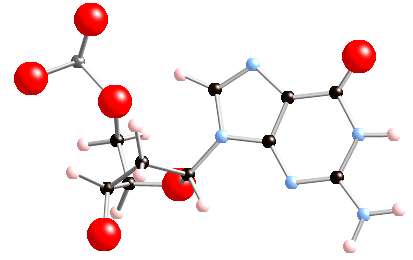Maths and Biology -Combinatorial analysis
In this section I will describe maths in 2 extremely important theories: DNA transcription and translation and also independent assortment in meiosis.
DNA : all life is written in a four letter code
DNA is a very long molecule formed by joining nucleotides together. What makes nucleotides different from each other is the bases they have. There are 4 varieties, represented by the

The base guanine , represented by G
The way DNA builds and controls life is through the synthesis of proteins. Proteins are a long sequence of aminoacids and each of them must be specified in the correct order.
There are 20 different aminoacids, so how many bases are needed to specify one particular aminoacids?
A single base have only four (4) varieties. If you use two of them, there are 16 possible combinations (42 ). That is still not enough to code for the 20 different aminoacids. Using a sequence of three bases, 64 combinations (43) are possible, and that is the answer. The sequences of three DNA nucleotides are called codons. For instance, the sequence CTT codes for the aminoacids phenylalanine and CAT for tyrosine.
This is a basic exercise of combinatorial analysis. Is like asking how many numbers can be made out of 2 digits. That would be 102 .
But now there are more than enough possibilities to code for the 20 aminoacids result is that each aminoacids can be accessed by more than a single combination of bases. The code is redundant.
Independent assortment
I will describe a situation that occurs during meiosis. Just to revise, meiosis is the type of cell division that produces gametes (haploid cells for reproduction made out of diploid cells) as opposed to mitosis, the kind of division where the cell produces copies of itself (both are diploid).
Independent assortment happens during meiosis, in Metaphase I. When the duplicated chromosomes and their homologues get aligned over the equatorial plane of the cell,just before being pulled to each side, there are two possibilities of positioning for each chromosome. Depending on which side they stay, they will be pulled to one side (and not to the other), forming a different gamete.
In how many different ways can the 23 pairs of chromosomes align , if each of them have 2 different ways of doing it ?
The calculation is similar to that on the DNA codon. The answer is 223 = 8.4 million .
In conclusion this process, allied to crossing over, enables an animal to produce very diverse offsprings. It is no surprise that is so rare to find two humans that have similar faces.
See also - Biology and Geometry
The size of cells: surface areas and volumes and the shapes of viruses: polyhedra >>
